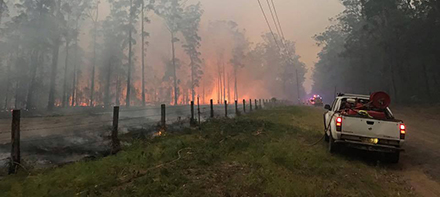With climate change set to drive bigger and hotter bushfires, much more money needs to be spent on preparations to mitigate against fires in the first place, according to Climate Councillor, Greg Mullins. Source: Philip Hopkins for Timberbiz
Mr Mullins, the former Commissioner of Fire & Rescue NSW, said the fire agencies community needed to “band together to make a bigger pie” instead of “fighting for the crumbs on the table”.
“It’s time for the fire management sector to band together and argue the case for a massive increase in the budget across fire research. Up to 97% of spending is on response and rebuilding during and after events, and only three per cent on preparation and mitigation. That mismatch needs to be turned around but not at the expense of insufficient current operational budgets,” he said.
Mr Mullins was making the keynote address at a recent three-day conference in Melbourne on ‘Fire and Climate’. It was presented by the International Association of Wildland Fire in partnership with Natural Hazards Research Australia, which is building on the work of its predecessor Cooperative Research Centres, the Bushfire CRC and the Bushfire and Natural Hazards CRC.
Mr Mullins said unfortunately, current fire management continued to have a clash of cultures between foresters, fire fighters, land managers and scientists. “These should be complementary, not competing. There should be no endless, pointless arguments about who is responsible,” he said. “In particular, we need clarity on future strategies on prescribed burning as it will become even more vital.”
The likelihood of hotter and drier summers through climate change was reducing the opportunities to burn safely.
“It’s either too wet or too hot and windy. Fires under extremely catastrophic conditions burn over most recent hazard reduced areas,” he said. “Progressively fire-prone weather is likely to make prescribed burning less effective into the future. What do we do? This is one of the only major tools. Some research is contradictory – thinning, the effects of logging, fire spread, self-thinning of old growth, reduction around human assets (communities) as the most effective approach in the future. We need to get together for the best guidance for people out there trying to deal with this.”
Mr Mullins was scathing on the performance of the Morrison Government regarding climate change and climate policies. The new Government, backed by the teals and Greens, offered the chance of a reset in policy.
“Fire management leaders can now speak out on the dangers of climate change and fire. They could be powerful and encourage the Government to do more,” he said.
Massive action could lead to a massive increase in funding, the development of new technologies in detection, rapid response and investment in remote area fire detection capabilities.
“Every fire starts small. There should be a focus on finding them and jumping on them before they get too big. Part of that focus must be in reaching broad agreement on prescribed burning and how to optimise and protect properties,” he said.
“That also includes work with cultural burning experts to remove the many institutional barriers to heal and protect Country. There is strong resistance from some government agencies and a plethora of risk-averse rules.”
Mr Mullins said the bottom line was that things on a human scale had changed for the worse forever and would only continue to worsen. “Hotter, drier, wilder weather will continue to drive bigger, hotter fires, with a focus on preparation. Some communities will need to be moved out of harm’s way,” he said. Bigger budgets and more in the fire space should be allied with community-led response programs.
Science needed to be trusted more by fire emergency agencies, whose warnings had been ignored in the past. “Some people don’t like hearing bad news. The chronic lack of funding is only patching up the system as conditions continue to worsen,” he said.
Mr Mullins said the Australian Climate Service, a formal recommendation of the Commonwealth Royal Commission RC, could be a strongly entity to conduct detailed, down-scale climate weather modelling. State and territory agencies responsible for emergency management could use this more confidently prepare for future.
“Frankly, I’m not sure what ACS has delivered so far,” he said. It appeared caught in a tug of war between the Bureau of Meteorology, the CSIRO and Geo Science Australia.
“Perhaps it should be placed in more neutral spot, such as the new Climate Change Authority when it is formed. It would have a clear mandate to deliver outputs to states and territories for fires driven by extreme weather never before experienced by human beings.”
Mr Mullins, who began fighting fires with his father in 1971, said fighting fires in NSW in the past was based on observations and generally panned out in a predictable way.
“I still remember after the 1994 fires, my dad said, ‘Things have changed, but I’m not sure why but I can’t predict the bad years anymore – the weather is all over the place’. He said that as did other old-timers.”
Mr Mullins said he had decided to speak out against political inertia and denialism regarding catastrophic bushfires and climate change fire.
“This came at a personal cost and emergency people like me were more than willing to pay given the stakes were so high,” he said.







